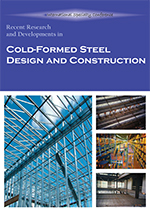Session Dates
24 Aug 2012 - 25 Aug 2012
Keywords and Phrases
Cold-formed steel, Bracing member, Shear lag, Net section failure
Abstract
This paper is concentrated mainly on the behaviour of bracing end connections for cold formed steel lipped angle and lipped channel sections. For bracing members, only one flange is possible to connect with tower leg member or supporting member, which causes uneven distribution of stresses in the end section popularly known as shear lag effect. Tension tests have been carried out to simulate the bracing end connections. Special test rig has been assembled and end fittings fabricated such that the load will be applied as concentric load at the pulling end and on the other end load is transferred through the connected flange only. All the specimens have been instrumented with dial gauges, to study the deformations and one specimen is instrumented with strain gauges to study the strain variation. The failure load for tested joints has been calculated by using various International Standards and compared with the test results.
Department(s)
Civil, Architectural and Environmental Engineering
Research Center/Lab(s)
Wei-Wen Yu Center for Cold-Formed Steel Structures
Meeting Name
21st International Specialty Conference on Cold-Formed Steel Structures
Publisher
Missouri University of Science and Technology
Document Version
Final Version
Rights
© 2012 Missouri University of Science and Technology, All rights reserved.
Document Type
Article - Conference proceedings
File Type
text
Language
English
Recommended Citation
Rokade, R. P.; Rao, N. Prasad; Balagopal, R.; and Mohan, S. J., "Studies on Bracing Member End Connections for Cold Formed Steel Sections" (2012). CCFSS Proceedings of International Specialty Conference on Cold-Formed Steel Structures (1971 - 2018). 5.
https://scholarsmine.mst.edu/isccss/21iccfss/21iccfss-session9/5
Studies on Bracing Member End Connections for Cold Formed Steel Sections
This paper is concentrated mainly on the behaviour of bracing end connections for cold formed steel lipped angle and lipped channel sections. For bracing members, only one flange is possible to connect with tower leg member or supporting member, which causes uneven distribution of stresses in the end section popularly known as shear lag effect. Tension tests have been carried out to simulate the bracing end connections. Special test rig has been assembled and end fittings fabricated such that the load will be applied as concentric load at the pulling end and on the other end load is transferred through the connected flange only. All the specimens have been instrumented with dial gauges, to study the deformations and one specimen is instrumented with strain gauges to study the strain variation. The failure load for tested joints has been calculated by using various International Standards and compared with the test results.



